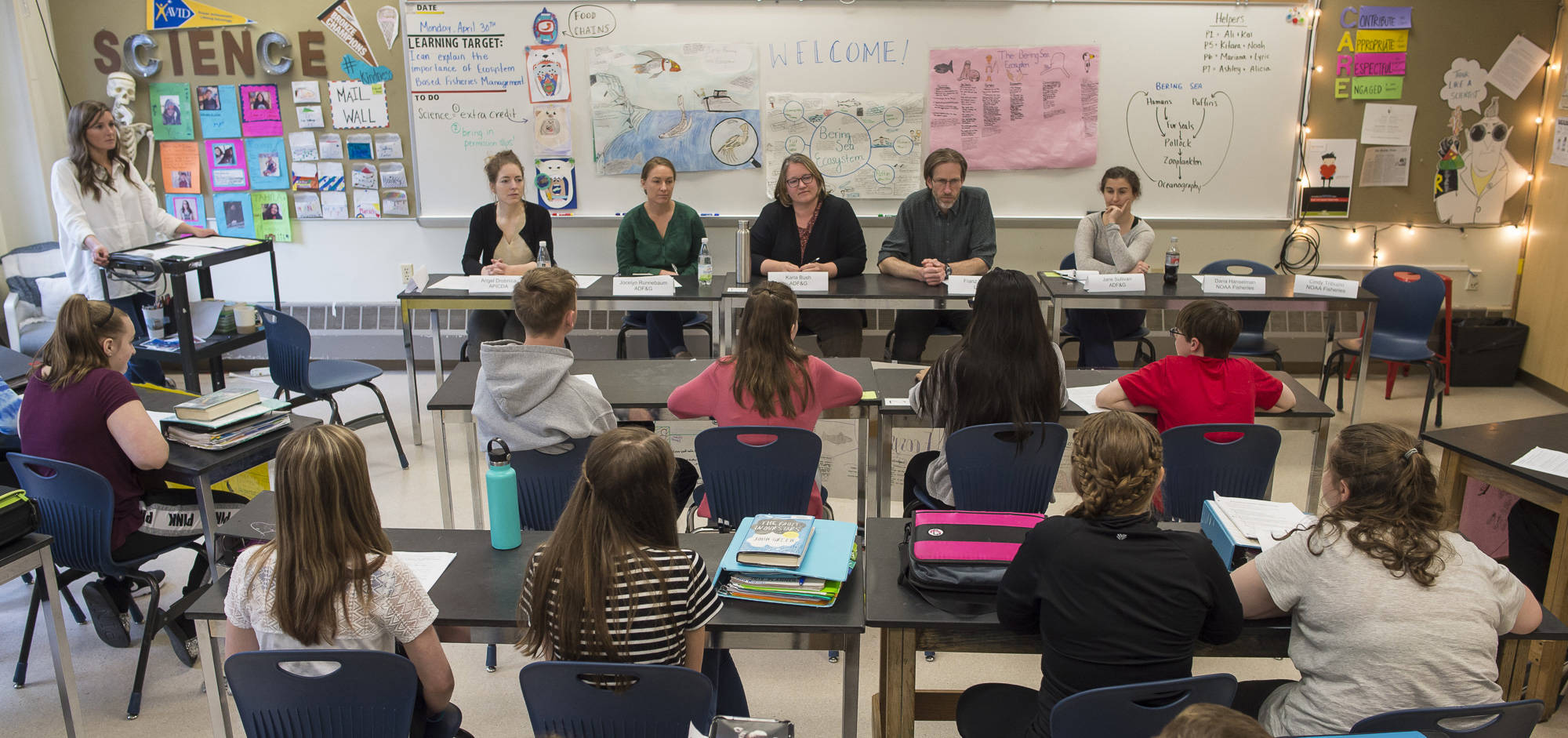Fisheries managers and scientists gathered on Tuesday for a serious discussion about pollock quotas in the Bering Sea.
The forum? Seventh-grade life science teacher Jessica Cobley’s classroom.
Aaliyah McCrehin wants to see walleye pollock quotas lowered. In front of a pink poster detailing her evidence, McCrehin outlined her position to the Empire. She explained that puffin and fur seals prey on pollock. Both are starving, she said, possibly because of a lack of pollock. Fishermen, therefore, should have their allocations cut, she said, to protect puffin and fur seal prey.
“It should be decreased because the puffins and fur seals are predators of the pollock, and the puffins are starting to die out, I think because of starvation,” McCrehin said.
Sporting a Wonder Woman T-shirt, the Floyd Dryden Middle School student prepared to make her argument to a mock “Fishery Management Council” on Tuesday. While the panel was an imitation — none of the decisions made would be implemented — the panelists themselves were not: Cobley was able to pull in real scientists and professionals who sit on various advisory panels.
The project was aided by the SouthEast Exchange, a newly-formed local initiative seeking to get more STEM professionals in the classroom. Cobley’s mock council, she said, grew out of the increasing collaboration between scientists and teachers taking place in classrooms across Juneau. It’s “place-based” and “culturally-relevant,” two descriptors of JSD’s new science curriculum, set to be rolled out next year.
“The community is pushing for it and the new science curriculum that we are implementing next year is really big on making real-life connections,” Cobley said.
The mock council project, part of a quarter-long ecosystems unit, will reach 105 students, Cobley said. She’s excited about JSD’s new curriculum because it helps students understand how they can apply their learning in future careers.
Sometimes “kids walk away understanding the concept but not what that looks like when you apply it to a job,” Cobley said. “They can’t really see that, other than ‘I am going to be a veterinarian,’ or ‘I am going to be a biologist,’ but don’t really know what that means to be. I thought it was just really cool to talk about ecosystems and then be able to have people who do this for their jobs and to have the kids learn a little bit about what that means.”
During the mock council meeting, panelists took their seats facing a group four students picked to present the class’ proposition. Students Tommy Pearson, Carly Phelps, Mercedes Cordero and Grant Pierson explained that pollock are not doing well in the Bering Sea, and it’s affecting other species.
“If these species falter, the ecosystem will struggle,” Cordero said.
Franz Mueter, a University of Alaska Fairbanks scientist who sits on a committee which advises the North Pacific Fishery Management Council (NPFMC) on scientific and technical matters, queried the students about sea ice. How might that affect their proposition to decrease pollock allocations?
“The ice in the Bering Sea is really, really far back this year already. There’s far less ice than there usually is, so I was wondering why that might matter to the pollock? How does that relate to how much food there is for the pollock?” Mueter asked.
When there’s more sea ice, it’s generally a colder year, one of Cobley’s students answered. When there’s less sea ice, it’s a warmer year. Colder years force pollock to put on more fat, which is better for the Bering Sea ecosystem and the fishing industry that depends on it, he said.
Karla Bush, an Alaska Department of Fish and Game coordinator who has served on NPFMC committees, asked the students how best to use ecosystem-based evidence when setting fisheries policy. At a real meeting, students might hear from the fishing industry, who might be unfriendly to a decrease in pollock allocations.
“I’ve heard fishermen say that ecosystem science is only ever used against them, it’s never used for them, so that’s why I asked you guys that,” Bush said.
A student answered that fishermen might be helped by the decrease as it would provide more pollock years down the line.
Ultimately, the panel didn’t accept a decrease in pollock quota, but they did acknowledge that a decrease could come if ecosystem monitoring continues to indicate that. The panel decided that a decrease in prey for puffin and fur seals might mean there’s less small pollock around. However, fishermen target adult pollock, meaning they couldn’t justify cutting down their catch.
Just like a real NPFMC meeting, the outcome had to account for the feelings of multiple stakeholders.
“From the fishery science perspective, the council process is a forum where science meets industry, policy and social science. So kind of showing that to kids that, you know, you don’t just get to wear one hat, you have to see it from all sides,” said Jocelyn Runnebaum, an ADFG scientist.
• Contact reporter Kevin Gullufsen at 523-2228 and kgullufsen@juneauempire.com. Follow him on Twitter at @KevinGullufsen.

